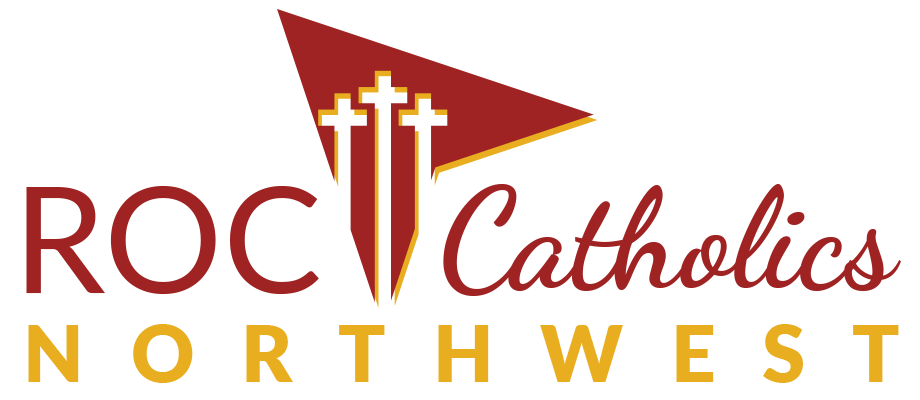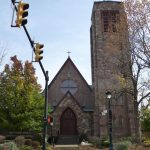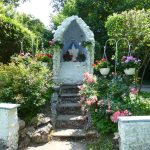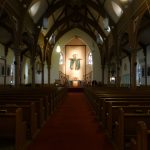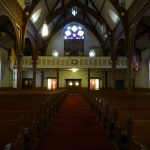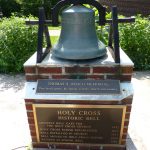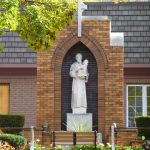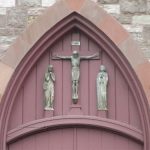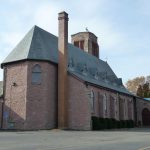4492 Lake Ave
Rochester, NY 14612
Phone: (585) 663-2244
Office hours: Monday 9:00 AM – 3:00 PM
Email:
Website: www.moshc.org
Mass Times:
Saturday: 5:00pm (Livestream)
Sunday: 8:00am
Sunday: 10:00am
Monday: 8:00am
Thursday: 8:00am
Friday: 8:00am
Confession Times
Saturday: 3:30pm - 4:30pm
Reconciliation by appointment
Adoration
Wednesday: 1:00pm - 5:00pm
Adoration of the Blessed Sacrament
Events:
Day of Penance & Adoration of Blessed Sacrament
April 2 @ 1:00 pm - 6:00 pm“The Seven Last Words of Jesus”
April 18 @ 7:00 pm - 9:00 pm
Holy Cross Church is a community, rich in talents, skills and gifts, and united in faith. We are a stable parish, fortunate to have a cross-section of ages including many who are second or third generation parishioners. Bring your gifts or your needs and you will find a hand to join with yours.
The First Holy Cross Church, Rectory, and Convent
In 1856, Fr. Louis Maurice, a French missionary priest was sent by Bishop Timons of Buffalo, NY to take charge of Mt Read Parish, known today as Our Mother of Sorrows. For two years, before a Catholic church was established in Charlotte, Fr. Maurice held Sunday school in the front room of a house, located to the rear of where the current church stands.
Holy Cross began as a mission church. Fr. Louis Maurice purchased the first strip of land from Luther Jethrods for $1,050 in the Fall of 1862. The renovated Mulligan home on the property became the first Holy Cross Church with 25 parishioners. An adjacent strip of land was purchased from Mrs. Nelson for $1,950 in 1863. The house became the priest’s residence until the present rectory was built in 1887, and then it became a convent for the Sisters of St. Joseph.
Holy Cross was blessed and dedicated by Bishop Timon of Buffalo on the Feast of the Finding of the Holy Cross. Fr. Maurice continued to travel from Our Mother of Sorrows until Bishop Timon appointed Fr. John J. Donnelly as the first resident pastor on July 7, 1873. The Mulligan house was enlarged several times over the next 14 years. During these years, the Fathers John Donnelly, Thomas Henricks, Simon FitzSimmons, and John Fitzgerald served as pastors. The building took the form of a cross, seating 400 people, and a bell was hung in the belfry on the west side.
The Beginnings of Today’s Church
In the early part of 1881, during the pastorate of Fr. Fitzgerald, the fourth resident pastor, church fairs and entertainment were held to raise money to advance the erection of a new church.
The cornerstone for the present church building was laid in the southwest corner of the church by Bishop McQuaid on August 28, 1881. It would cost $13,000 by the time it was dedicated on December 10, 1882.
The cornerstone contained the following articles that were sealed in a tin box: chronological records of the Popes up to Pope Leo XIII; records of Holy Cross Church including information regarding the original stained-glass windows; copies of daily and weekly newspapers of Rochester; names of benefactors of the church, the priests, the architect, and the builder; as well as domestic and foreign coins.
Growth and Renovation
The growth of the parish, as shown by the need for larger buildings and a school, is indicative of the growth of the Charlotte community at the turn of the century. Holy Cross Parish became a vital part of the development of the community as its pastors and members actively participated in the Charlotte community.
From 1895 through 1913, new pews were added, the sanctuary was re-carpeted, and a pipe organ was purchased by Fr. William Payne.
During Fr. McCabe’s first 10 years of ministry at Holy Cross, the rectory was improved, the convent remodeled, the church grounds beautified, the church altered to increase the seating capacity, the tower on the church completed, and the new bell, donated by Lawrence Sexton and blessed by Bishop Hickey on May 27, 1923, hung, new floors were laid, new electric fixtures were installed, and the interior of the church redecorated by Arnold and Stern. New donated Stations of the Cross were created by Jos Sibbel Studios and installed around 1923 -24. New windows, commissioned by Fr. McCabe from Franz Mayer & Co. of Munich, were donated to replace the old ones. Production and installation of these windows in 1923 cost $3,940, or over $50,000 in today’s market. The Rose window is one of the few remaining original windows, making it 122 years-old.
On January 6, 1920, Fr McCabe purchased a third strip of land for the parish, extending along Lighthouse Street to Latta Road.
The Footprint and Influence of Holy Cross Parish Continues to Grow in the Community
Fr. Lawrence Casey became pastor in 1946. From that time until 1952, he added to the property by purchasing more land surrounding the church grounds, including the Virgil House and property facing Lake Avenue. With the cooperation of the parishioners, Fr. Casey replaced the church roof with one of slate, modernized the altars and pews, completely redecorated the church, and added a new South entrance with the commission for 2 new windows, modernized the rectory, and completed the Shrine of Our Lady of Peace.
In 1946, four brothers from the Hoysic family (Joe, George, Pete, and Bill) had the grotto for Holy Mary built on the lawn north of the convent to give thanks to our Blessed Mother for her intercession that brought them all home safely from WWII. They also wanted to dedicate it to all the boys of Charlotte who didn’t make it home.
In 1952, Fr. Joseph O’Connell came to Holy Cross. He recognized that the growth of the parish demanded that more additions be made, especially to the school and the convent. Plans were begun to add the North addition to the school which included 5 classrooms, offices, cafeteria, meeting rooms, and rest rooms, and to renovate and enlarge the convent. The north entrance, baptistery, and mother’s room were added to the church, requiring the removal of the large window depicting the Home at Nazareth along the north wall, switching it with the Baptism of Jesus along the south wall, and then reinstalling them both. It also called for another commission from Pike Stained Glass Studios to create 4 more one-light windows. The total cost of the 1954 Expansion Project was $300,000. Parishioners were asked to sacrifice a day’s pay per month for 30 months.
Ill health forced Fr. O’Connell to leave the work to a new pastor, Fr. Robert Fennessy, in 1955. With the help of dedicated parishioners, Fr. O’Connell’s goals became realities along with the addition of the St. Anthony Shrine built by the people of Holy Cross.
The Impact of Vatican II
With the major building projects completed, the parish began to focus on the new winds of change taking place in the Roman Catholic Church. Vatican Council II, begun in 1962, called for changes that affected how we worshipped, the role of lay people, our relationships with non-Catholics, our access to Scripture, and how we should live out the Gospel spirit of love toward God, neighbor, and self.
Emphasis on the Church as being the People of God deepened the already existing spirit of community at Holy Cross Parish. Parishioners took on more active roles in the leadership of the parish through pastoral councils, planning groups and committees, and liturgical ministries. The identification of new needs in the parish led to an increase in non-ordained pastoral staff as the parish reached out to the children, families, the elderly, and the alienated.
Under the leadership of Fr. Fennessy, Fr. J Patrick O’Malley, and our next pastor, Fr. Thomas H. Wheeland, the changes initiated by the Second Vatican Council have not only preserved the tradition of Holy Cross Parish as family and community but continue to enhance the spirit of Holy Cross.
1977 saw the acquisition of more land in front of the lighthouse on the Lake Avenue side when the Federal government declared it as surplus land.
Our Centennial
We celebrated the Centennial of Holy Cross on August 22, 1983, with an outdoor Mass of Thanksgiving celebrated by Bishop Matthew Clark.
Our Next Pastor
Fr Wheeland came to Holy Cross in 1982. He oversaw many renovations between January 2 and March 30, 1985. A Palm Sunday procession from the school auditorium to the Church revealed a new sanctuary area, the creation of a Blessed Sacrament Chapel with wrought iron gates (medallions depict six sacraments with the tabernacle, the Eucharist, as the 7th sacrament and the central focus), the installation of the Holy Cross, a change to the colors of the walls and ceiling, installation of burgundy carpeting, the location change of the baptismal area to the south front transept of the church, the conversion of the former baptistery into a room for vesting and for the Sacrament of Reconciliation, the replacement of gutters and repair of the roof, and the covering of the stained glass windows with plexiglass. The renovated church was dedicated on June 1, 1985, by Bishop Matthew Clark.
Diocesan Synod
In 1993, Bishop Clark presided over a Diocesan Synod which reminded us of the necessity of lifelong faith formation for Catholics, a consistent life ethic, support for the role of women in the Church, the importance of nurturing spirituality and discipleship for daily living. Bishop Clark continued to insist on the dignity of the human person, the importance of reconciliation and healing among the members of the community of the Church, and the value of hope in the Spirit who leads the Church.
Church Installs New Pipe Organ and Additional Worship Space
In 1995, an Opus 48 Organ, built by Bedient Pipe Organ Company of Lincoln, Nebraska, was installed, replacing the original organ installed around 1913. Take notice of the pipe case, specifically designed with symbols reflective of Holy Cross and the Charlotte area—celtic cross, anchor, lighthouse, rose window and motifs reminiscent of the church architecture and carvings. A memorial stands at the base of the stairs to the choir loft in recognition of those whose financial support made it possible.
As ministries of the parish continued to grow, and as the involvement of the parishioners continued to increase, so too did the need for additional space. On January 3, 1999, Bishop Matthew Clark dedicated a new seating area with 70 additional seats for the worship space and a new parish center, built for the enjoyment of all parishioners.
Playground Dedicated to Father O’Malley, 10th Resident Pastor of Holy Cross
From 2006-2007, Holy Cross Parish and Holy Cross School raised the money to build a new playground. Many shared their time and talent to design and pull the playground and the brick walkway together. The playground, the Rev. John Patrick O'Malley Memorial Playground, was dedicated on June 3, 2007. Mayor Bob Duffy and Congressman Joe Robach were among those in attendance. A time capsule was buried on the site and won't be opened again until 2032!
More Upgrades and Additions
Air conditioning was installed in the Fall of 2003 to be used for the first time in the Spring of 2004. The Holy Cross School Gym was renovated in 2005, and the parish offices were completed in 2006.
Holy Cross Parish Over the Last Decade
As Fr. Wheeland wound down his tenure as Pastor, he continued to enthusiastically lead Holy Cross into the future. He embraced current technology, utilizing the internet for a website, social media, and live-streaming videos of weekly Masses and Special Celebrations to continue to reach out to those beyond our walls. He envisioned a transformation of the current convent into a Living Center for Senior Priests. The parish house facing Latta Rd has housed a gift shop, youth activities, and may serve as additional classroom space for our growing Preschool program. The year’s Preserving the Past & Building the Future capital campaign helped maintain the integrity of our infrastructure and ensure the financial stability of the parish and school for future generations.
Father John F. Gagnier became the thirteenth pastor of Holy Cross in June 2017. Through his leadership, Holy Cross again secured its financial footing and parishioners continued to grow in faith.
In 2020, Bishop Salvatore R. Matano asked The Very Rev. William G. Coffas, VF, pastor of Our Mother of Sorrows, to also become the pastor of Holy Cross. The parishes remain distinct but, from the beginning, Father Coffas has encouraged building a bridge between the two. Where possible, sharing resources such as a combined bulletin and combining ministries such as Lenten Retreats, continues to take place. This has led to parishioners from each church engaging and getting to know each other.
